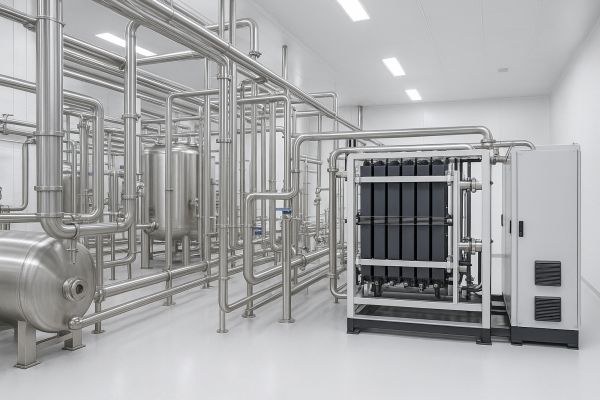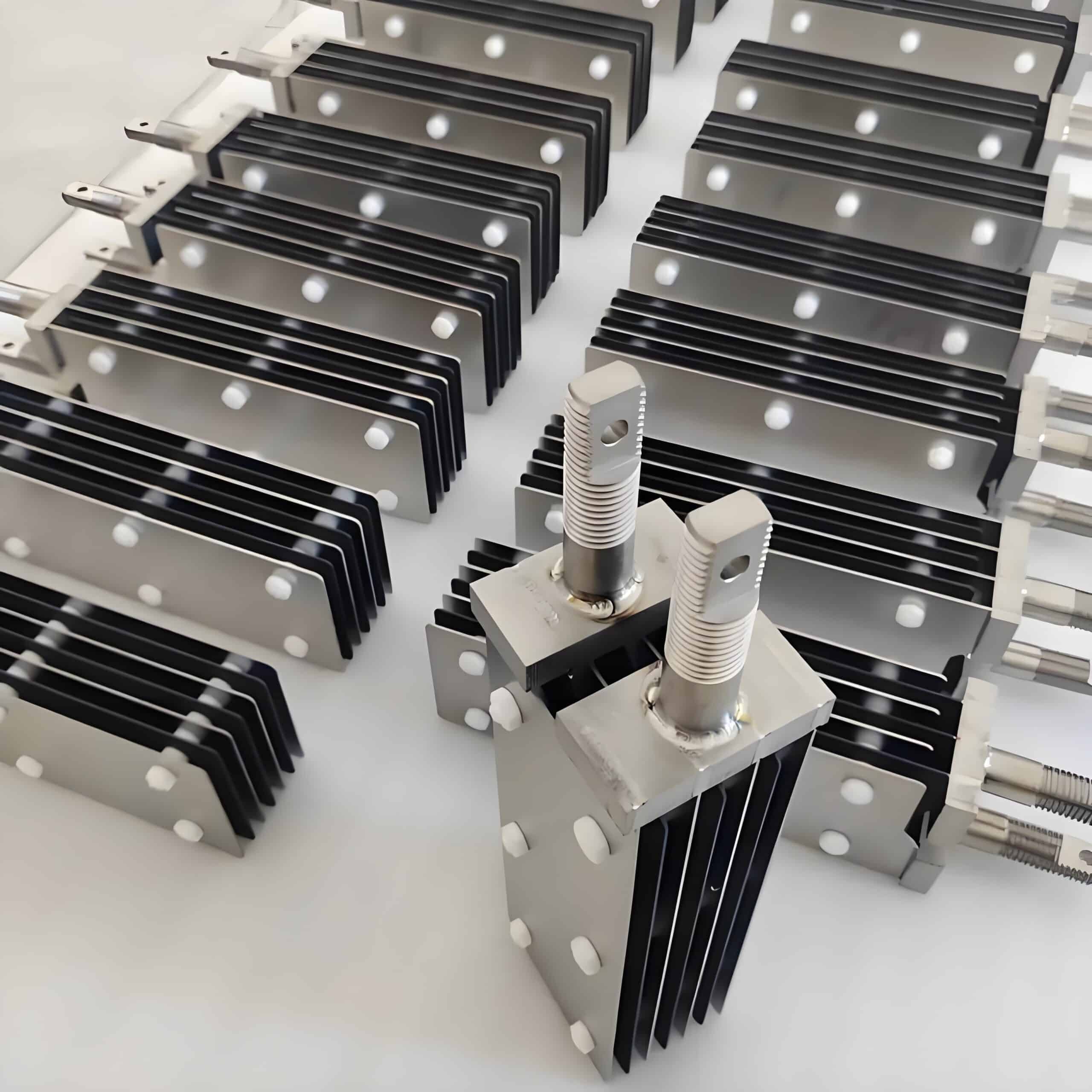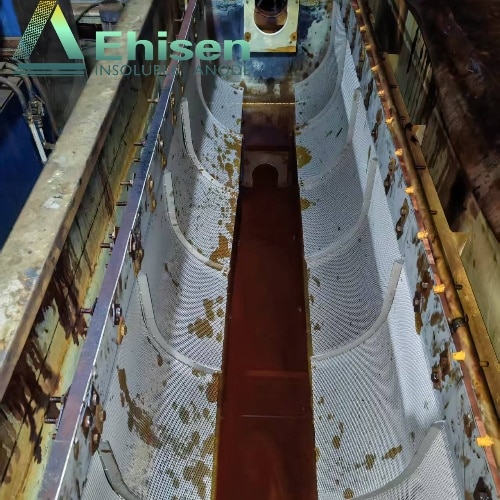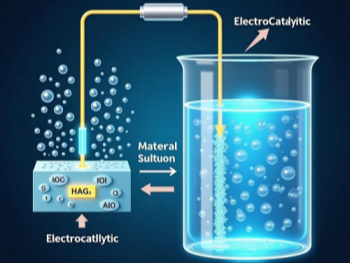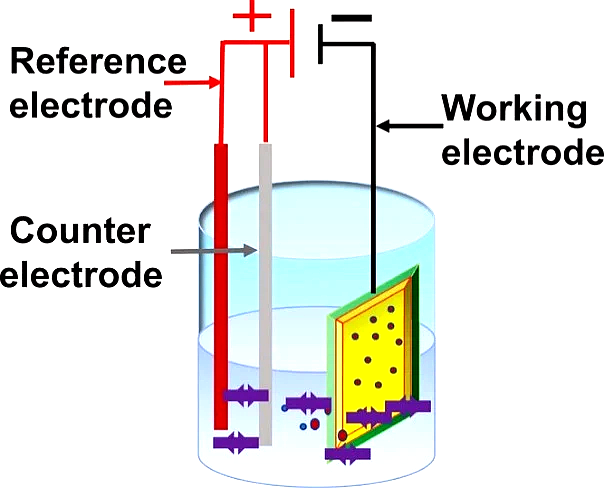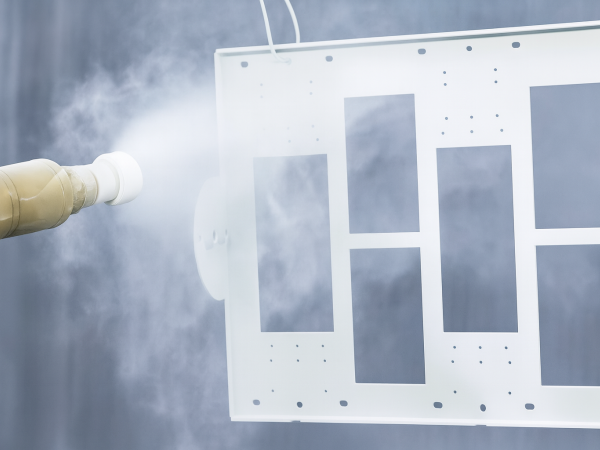Introduction
Titanium anodes, particularly those coated with mixed metal oxides (MMO), are critical components in numerous electrochemical processes, including chlor-alkali production, cathodic protection, electrowinning, and water electrolysis. Predicting their operational lifespan accurately is paramount for process efficiency, safety, and cost management. Unlike simple mechanical components, anode degradation involves complex electrochemical, chemical, and physical mechanisms occurring at the electrode-electrolyte interface and within the coating/substrate system. This guide details the core laboratory methodologies – Electrochemical Testing, Cyclic Polarization, Thermal Cycling, and Accelerated Corrosion Testing – employed to rigorously evaluate and predict titanium anode service life, explaining the what, why, and how of each technique.
I. Fundamental Electrochemical Characterization
Electrochemical testing serves as the foundation and starting point for evaluating the performance and service life of titanium anodes. It is primarily conducted by measuring Open Circuit Potential (OCP), Electrochemical Impedance Spectroscopy (EIS), and Cyclic Voltammetry (CV). These methods can non-destructively or minimally invasively reveal the anode’s thermodynamic stability in the electrolyte, coating interface characteristics (such as porosity and integrity), reaction kinetics (catalytic activity), and early signs of degradation. Its core purpose is to establish a comprehensive “electrochemical fingerprint” to quantitatively monitor key parameters like coating activity, resistance, and capacitance as they change over time and under different environmental conditions. This provides crucial baseline data and analytical basis for assessing the anode’s health status and for subsequent, more aggressive accelerated tests.

Purpose: To establish baseline electrochemical behavior, understand reaction kinetics, identify degradation onset, and monitor fundamental property changes (coating activity, resistivity, capacitance) over time or under simulated conditions. These tests are often prerequisites for interpreting more aggressive accelerated tests.
Procedure: Immerse the anode in the relevant electrolyte (e.g., simulated process solution, 3.5% NaCl for cathodic protection, H2SO4 for electrowinning) without applying any external current or potential. Monitor the potential between the anode and a stable reference electrode (e.g., Saturated Calomel Electrode – SCE, or Silver/Silver Chloride – Ag/AgCl) until it stabilizes (typically minutes to hours).
Purpose: Determines the inherent thermodynamic tendency of the anode material to corrode or react spontaneously in the specific environment. A stable and noble (positive) OCP generally indicates a stable, intact coating. A shift towards more active (negative) potentials can signal coating degradation, exposure of the titanium substrate, or changes in the oxide layer.
Key Metrics:
Stabilized OCP Value: Reported vs. a standard reference electrode (e.g., vs. SCE). Compare initial vs. post-test or post-aging values.
OCP Drift: Rate or magnitude of change over time during the stabilization period or during long-term monitoring.
OCP Stability: Fluctuations or noise in the OCP signal can indicate localized corrosion initiation or unstable surface conditions.
Procedure: Apply a small amplitude sinusoidal AC voltage (typically 5-20 mV RMS) across a wide frequency range (e.g., 100 kHz to 10 mHz or lower) to the anode (working electrode) versus a reference electrode, while measuring the resulting AC current. Conduct this at the OCP or at a chosen DC bias potential relevant to the operating conditions.
Purpose: Probes the dielectric and conductive properties of the electrode/electrolyte interface non-destructively. It effectively “fingerprints” the system, revealing information about:
Coating porosity and integrity.
Double-layer capacitance at the coating/electrolyte interface.
Charge transfer resistance of the electrocatalytic reaction(s).
Coating resistance (ohmic drop within the coating).
Diffusion processes (Warburg impedance).
Onset of substrate corrosion (low-frequency behavior).
Key Metrics (Extracted via Equivalent Circuit Modeling):
Solution Resistance (Rs): Resistance of the electrolyte between reference electrode tip and anode surface. Affected by conductivity, geometry.
Coating Pore Resistance (Rpore): Resistance to ionic current flow through pores/cracks in the coating. Decreases as coating degrades/becomes porous.
Coating Capacitance (Ccoat) / Constant Phase Element (CPEcoat): Related to the dielectric properties and effective surface area of the coating. Increases with porosity/cracking (more electrolyte penetration) or delamination.
Charge Transfer Resistance (Rct): Resistance associated with the speed of the desired electrochemical reaction (e.g., Cl⁻ oxidation, OER). Lower Rct generally indicates higher intrinsic catalytic activity. Increases can indicate passivation or loss of active sites. Decreases might indicate unwanted side reactions (e.g., substrate corrosion) becoming significant.
Double Layer Capacitance (Cdl) / CPEdl: Capacitance at the interface where the electrochemical reaction occurs. Increases with true electrochemical surface area (roughness, porosity).
Warburg Coefficient (σ): Indicates diffusion limitations. Important if reactant supply or product removal is rate-limiting.
CPE Exponent (n): Reflects the “ideality” of the capacitive element (n=1 for ideal capacitor, n<1 indicates surface heterogeneity, porosity, or distributed time constants). Tracking changes in ‘n’ provides insight into microstructural evolution.
Procedure: Apply a linearly varying potential (scan) to the anode versus a reference electrode, sweeping back and forth between predefined anodic and cathodic limits at a controlled scan rate (e.g., 5-100 mV/s). Measure the resulting current.
Purpose:
Identify redox processes occurring on the anode surface (e.g., oxidation/reduction of coating oxides, chlorine evolution, oxygen evolution, substrate corrosion).
Estimate the electrochemically active surface area (ECSA) via the charge under characteristic peaks (if applicable) or double-layer capacitance region.
Qualitatively assess coating stability by observing changes in peak shapes, positions, and intensities over multiple cycles or after aging.
Investigate reaction mechanisms (reversibility).
Key Metrics:
Peak Potentials (Epa, Epc): Potentials where oxidation and reduction peaks occur.
Peak Currents (Ipa, Ipc): Magnitude of oxidation and reduction currents. Proportional to active surface area and reaction rate.
Peak Separation (ΔEp = Epa – Epc): Indicator of reaction reversibility (smaller ΔEp = more reversible).
Charge Under Peaks (Q): Integral of current over time for a peak. Related to the quantity of active material involved in the redox process. Decreases as coating degrades or active sites are lost.
Background Current: Current density in the potential region where the main reaction occurs (e.g., OER plateau). Indicates catalytic activity for the target process. Changes signal deactivation.
Onset Potential for Reactions: Potential where significant current for a specific reaction (e.g., OER, substrate corrosion) begins.
II. Cyclic Polarization Testing
Cyclic polarization testing is a critical method specifically designed to assess the ability of titanium anodes to resist localized pitting corrosion. This test involves cyclically scanning the anode’s potential within a specific aggressive electrolyte and observing the current response to accurately determine two key parameters: the breakdown potential (Epit) and the repassivation potential (Eprot). Its main purpose is to examine the stability of the passive film on the anode surface and the coating’s ability to protect the substrate, providing a direct early warning against sudden failure risks caused by pitting. The hysteresis loop formed during the test and its area intuitively reflect the difficulty of pit initiation and the repassivation capability of existing pits. It is a crucial criterion for predicting whether the anode can operate stably for the long term in harsh environments containing chloride ions, among others.

Purpose: To specifically evaluate the susceptibility of the titanium anode to localized pitting corrosion, a critical failure mode. It assesses the stability and protective nature of the passive film (the oxide layer on the titanium substrate beneath the MMO coating) and the coating’s ability to shield the substrate. It directly probes the risk of catastrophic failure due to pitting.
Procedure:
1.Immerse the anode in a deaerated, aggressive electrolyte relevant to potential failure scenarios (e.g., low pH, high Cl⁻ concentration). Deaeration (usually with N₂ or Ar) is crucial to remove oxygen, which can mask pitting behavior.
2.Start scanning the potential from a value slightly below the OCP in the anodic (positive) direction at a slow, controlled scan rate (e.g., 0.1 – 1 mV/s).
3.Continue scanning until the current density increases sharply and significantly, indicating the breakdown of passivity and pit initiation (Breakdown Potential, Eb or Epit).
4.Immediately reverse the scan direction back towards the cathodic (negative) direction.
5.Continue the reverse scan until the current decreases back to near the passive current level or crosses the forward scan curve.
Purpose: The hysteresis loop formed between the forward and reverse scans is key:
Forward Scan: Reveals the passive region (low current) and the critical potential (Epit) where localized breakdown (pitting) initiates.
Reverse Scan: Reveals whether pits repassivate (current drops sharply) or continue propagating actively even as the potential is lowered. The potential where the reverse scan current drops back to the passive current level is the Repassivation Potential or Protection Potential (Eprot).
Key Metrics & Interpretation:
Breakdown Potential (Epit): The potential at which a sharp, sustained increase in current occurs during the forward scan, indicating stable pit initiation. A more noble (more positive) Epit indicates greater resistance to pitting initiation. Lower Epit means easier pit initiation.
Repassivation/Protection Potential (Eprot): The potential on the reverse scan where the current density falls back to the level of the passive current density (indicating pits stop growing and repassivate). This is arguably the most critical parameter. If Eprot is more noble than the anode’s operating potential, existing pits will repassivate, and localized corrosion is unlikely to propagate. If the operating potential is more noble than Eprot, any initiated pits will continue to grow, leading to severe localized attack and failure.
Hysteresis Loop Area: The area enclosed between the forward and reverse scans. A larger hysteresis loop generally indicates greater difficulty in repassivating pits once formed, signifying higher susceptibility to sustained, damaging pitting corrosion. A small or negligible loop suggests easy repassivation.
Passive Current Density (ipass): The relatively low, stable current density observed before breakdown. Reflects the general corrosion rate in the passive state. A gradual increase before breakdown can indicate metastable pitting or general weakening of the passive film.
Significance for Lifespan: An anode with a high Epit and, crucially, a very noble Eprot (significantly above its operating potential) is highly resistant to pitting failure. Monitoring how Eprot shifts (becomes less noble) after aging or exposure provides a direct measure of increasing susceptibility to localized corrosion over time. This is a vital predictor of long-term integrity, especially in chloride-containing environments.
III. Thermal Cycling Testing
Thermal cycling testing aims to assess the mechanical and structural durability of titanium anodes, particularly the stability of the bond between the Mixed Metal Oxide (MMO) coating and the titanium substrate under thermal stress. The test subjects the anode to dozens or even thousands of repeated cycles within a set high-low temperature range to simulate common real-world application scenarios like start-stop operations, intermittent use, or ambient temperature fluctuations. The principle relies on the difference in the coefficient of thermal expansion between the metallic substrate and the ceramic coating, which induces failure modes such as coating cracking, spalling, or delamination from the substrate under alternating thermal stress. The objective of this test is to screen anode products with excellent thermal fatigue resistance, ensuring they can maintain physical integrity and reliable electrical connection in application scenarios involving temperature variations, thereby preventing premature failure due to thermal stress.

Procedure:
Define the temperature range and dwell times. Typical ranges might be from room temperature (RT, ~25°C) to a high temperature relevant to the process or worst-case scenario (e.g., 80°C, 100°C, 120°C). Dwell times at high and low temperatures are usually equal and sufficient for thermal equilibration (e.g., 15-60 minutes).
Place the anode in an oven capable of controlled heating and cooling cycles. The cooling phase is often the most critical (rapid quenching stress).
Subject the anode to repeated cycles (e.g., 50, 100, 500, 1000 cycles).
Periodically (e.g., every 50 or 100 cycles), remove samples for visual inspection, microscopic examination (optical microscope, SEM), and potentially electrochemical characterization (OCP, EIS) to detect degradation.
Purpose: Induce and accelerate failure modes driven by thermomechanical fatigue:
Coating Cracking: Due to tensile stresses during cooling (coating contracts less than substrate).
Coating Delamination/Buckling: Due to compressive stresses during heating (coating expands less than substrate) or interfacial weakness.
Increased Porosity: Micro-cracks opening pathways to the substrate.
Loss of Electrical Contact: Delamination separating the coating electronically from the substrate.
Key Metrics & Failure Criteria:
Number of Cycles to First Visible Defect: Visual observation of cracks, blisters, or flaking.
Number of Cycles to Significant Electrochemical Degradation: Measured by:
Substantial drop in OCP (towards active Ti potentials).
Significant decrease in Rpore or Rct in EIS (indicating coating penetration or loss of activity).
Increase in Ccoat/CPEcoat magnitude in EIS (indicating increased porosity/delamination).
Emergence of Ti oxidation/reduction peaks in CV.
Characterization of Failure Mode: Post-mortem analysis using microscopy (SEM/EDS) to identify the nature and location of failures (cohesive vs. adhesive failure, crack propagation paths, evidence of substrate oxidation).
Coating Weight Loss: Careful measurement before and after extensive cycling (if failure is severe).
Significance for Lifespan: Thermal cycling resistance is crucial for anodes in applications with non-continuous operation or significant temperature variations. The number of cycles sustained before measurable degradation provides a comparative metric for coating adhesion and thermomechanical durability. Anodes failing early in thermal cycling are unlikely to survive long-term in real-world environments with thermal fluctuations.
IV. Accelerated Corrosion / Electrochemical Aging Testing
Accelerated corrosion testing (or electrochemical aging testing) is a core accelerated method for predicting the long-term service life of titanium anodes. This method applies harsh conditions far exceeding normal operating parameters (such as extremely high current density, potential, or temperature, or using more corrosive media) to actively accelerate the coating’s consumption, deactivation, and the substrate’s corrosion process. This simulates the degraded state of the anode after long-term operation within a short time frame. Its core principle is based on electrochemical kinetics laws (such as the Arrhenius equation and Tafel relationship), exponentially increasing reaction rates by elevating stress levels to compress the timescale. The central purpose of the test is to quickly compare the durability of different anode formulations in the laboratory, identify the primary failure mechanisms, and, by monitoring the trends of key performance parameters (such as potential drift, current decay), extrapolate and estimate the anode’s expected service life under normal operating conditions. This provides critical data support for product selection, quality control, and maintenance planning.

Purpose: To simulate years of operational degradation within a compressed laboratory timeframe by exposing the anode to conditions significantly harsher than normal operation (elevated temperature, higher current density, aggressive chemistry). The goal is to induce the dominant degradation mechanisms (coating dissolution, passivation, substrate corrosion via coating defects) at an accelerated rate.
Core Principle: Apply a severe but controlled electrochemical stress (constant current, constant potential, or potentiostatic/galvanostatic pulses) while often simultaneously elevating temperature. The acceleration factor is derived from fundamental electrochemical kinetics (e.g., Arrhenius equation for temperature, Tafel kinetics for current/voltage).
Procedure: Apply a constant anodic current density significantly higher than the normal operating current density (e.g., 2x, 5x, 10x) to the anode immersed in the relevant electrolyte (or an accelerated version, e.g., lower pH, higher Cl⁻) at an elevated temperature (e.g., 40-80°C, relevant to process limits or known acceleration factors). Monitor the anode potential versus a reference electrode continuously. Duration can range from hours to weeks.
Purpose: Accelerate consumption of the active coating material (dissolution) and force high reaction rates that may lead to coating damage or promote side reactions (e.g., oxygen evolution damaging coating structure). The evolution of the anode potential is a key indicator.
Key Metrics & Degradation Indicators:
Potential Drift: A gradual increase in anode potential at constant current indicates deactivation – the coating is becoming less catalytic, requiring more energy (higher overpotential) to drive the same reaction rate. This is a primary failure mode. A sudden drop in potential can indicate catastrophic failure (coating loss exposing active Ti substrate).
Time/Total Charge Passed to Reach Critical Potential Drift: Define a threshold (e.g., +100 mV, +200 mV increase) signifying unacceptable deactivation. The time or total charge passed (Current Density * Time * Area) to reach this threshold is the primary lifespan indicator under this test.
Post-Test Examination: Coating weight loss, visual inspection (coating loss, substrate attack), SEM/EDS analysis of coating morphology and composition changes, cross-section analysis for coating thinning and substrate penetration.
2.Potentiostatic Aging at Elevated Potential:
Procedure: Hold the anode at a constant anodic potential significantly higher than the normal operating potential (e.g., +0.5V, +1.0V above OCP or operating point) in the relevant or accelerated electrolyte at elevated temperature.
Purpose: Accelerate oxidation processes, promote oxygen evolution (which can mechanically damage coatings), and accelerate corrosion processes. Particularly useful for studying stability under transients or anode reversal conditions.
Key Metrics & Degradation Indicators:
Current Decay: A gradual decrease in current density at constant potential indicates deactivation – loss of catalytic activity. The rate of decay is a key indicator.
Time/Total Charge Passed to Reach Critical Current Decay: Define a threshold (e.g., 50% loss of initial current). Time/charge to threshold indicates lifespan.
Post-Test Examination: As per Galvanostatic Aging.
Procedure: Immerse the anode in the operating electrolyte (or an aggressive variant) at a significantly elevated temperature (e.g., 60-90°C) without applied current/potential. Duration: days to months.
Purpose: Accelerate purely chemical dissolution/degradation mechanisms of the coating oxides. Simulates downtime or non-operating periods in harsh chemical environments.
Key Metrics:
Weight Loss: Primary metric. Measure anode weight before and after immersion with high precision. Requires thorough cleaning to remove corrosion products. Weight loss rate (mg/cm²/day or similar) is calculated.
Solution Analysis: Measure dissolved metal ions (Ti, Ru, Ir, Ta, Sn etc.) in the electrolyte via ICP-MS or AAS to quantify dissolution rates.
Post-Immersion Electrochemical Testing: OCP, EIS, CV to assess impact of chemical attack on electrochemical performance.
Visual/SEM Inspection: Surface morphology changes, pitting, coating loss.
Critical Considerations for Accelerated Testing:
Acceleration Factor Validity: The fundamental challenge. Acceleration must not change the dominant degradation mechanism. For example, excessively high current density might cause oxygen bubble damage masking normal dissolution, or very high temperature might activate unrealistic diffusion paths. Validation against real-world performance or lower-acceleration tests is essential. Acceleration factors are often empirically derived for specific coating/application pairs.
Electrolyte Selection: Using the actual process electrolyte is ideal but sometimes impractical for long tests. Simulated electrolytes must accurately replicate key aggressive species (Cl⁻, F⁻, H⁺, SO₄²⁻ etc.). Beware of introducing unrealistic contaminants.
Defining Failure Criteria: Must be relevant to the application. Is it a 10% voltage increase? A 20% current decrease? Coating exposure? Establishing a clear, measurable endpoint is crucial for comparing different anodes or batches.
Extrapolation to Service Life: Lifespan prediction involves extrapolating the accelerated test results (e.g., charge passed to failure) back to normal operating conditions using the acceleration factor. This extrapolation carries significant uncertainty. Results are best used for comparative ranking of anodes or quality control, not absolute lifetime guarantees. Formula often used: Service Life ≈ (Accelerated Test Life * Acceleration Factor) / Duty Cycle. Duty cycle accounts for actual operating time vs. calendar time.
V. Integrating Test Results for Lifespan Prediction
No single test provides a complete picture. A robust lifespan assessment strategy integrates findings:
1.Baseline Characterization: Initial OCP, EIS, CV, Cyclic Polarization establish the “healthy” state.
2.Targeted Accelerated Aging: Apply Galvanostatic/Potentiostatic aging, Thermal Cycling, or Elevated Temp Immersion based on the dominant expected field failure modes.
3.Intermittent Monitoring: During aging, periodically perform non-destructive or minimally destructive tests (OCP, EIS, visual inspection).
4.Post-Aging Characterization: Repeat baseline electrochemical tests and Cyclic Polarization after aging. Perform destructive analysis (SEM/EDS, cross-section, weight loss).
5.Correlation: Link changes in electrochemical parameters (Rct decrease, OCP drop, Eprot shift, potential drift) and physical parameters (cracking, weight loss) to specific degradation mechanisms and progression rates.
6.Comparative Analysis: Rank different anode types, batches, or coating formulations based on performance across the test suite.
7.Mechanistic Understanding: Use the combined data to build a model of how the anode degrades (e.g., gradual dissolution -> increased overpotential -> localized coating breakdown -> substrate attack -> failure). This informs both prediction and potential coating improvements.
8.Conservative Prediction: Apply acceleration factors cautiously, incorporating safety margins. Report predictions as ranges with defined confidence levels based on test variability and extrapolation uncertainty.
VI. Conclusion
Predicting the service life of titanium anodes is complex but achievable through a systematic application of electrochemical, physical, and accelerated testing methods. Fundamental electrochemical characterization (OCP, EIS, CV) provides insights into initial state, reaction kinetics, and early degradation signs. Cyclic Polarization directly probes the critical risk of pitting corrosion. Thermal Cycling assesses mechanical integrity under thermal stress. Accelerated Corrosion Testing (Galvanostatic/Potentiostatic aging, Elevated Temp Immersion) compresses time to reveal dominant degradation pathways.
The power lies not in any single test, but in the synergistic interpretation of results from this comprehensive battery. By understanding the “what” (specific procedures), the “why” (purpose and underlying mechanisms), and the “how” (key metrics and their interpretation) of each method, manufacturers and users like Ehisen can make informed decisions about anode selection, process optimization, maintenance scheduling, and ultimately, predict operational longevity with greater confidence. Rigorous testing, coupled with a clear understanding of acceleration limitations and a focus on comparative performance, forms the cornerstone of reliable titanium anode technology deployment. Continuous refinement of these test protocols, aligned with field experience, remains essential for advancing the durability and efficiency of electrochemical processes reliant on these vital components.

